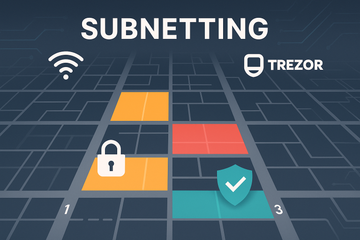Picture this: you’re tidying up your workspace, finally corralling pens, receipts, and thumb drives into their rightful drawers. Feels satisfying, right? Now imagine the “clutter” in a digital network—the endless tangle of devices, signals, and addresses. This is where the humble subnet (or sub-network) quietly shines, streamlining chaos into something orderly and efficient.
What Exactly is a Subnet? Let’s Kick Off Simple
At its core, a subnet is just a network living inside another network. Think of it as a neighborhood carved out from a sprawling city. In networking, you start with a big block of IP addresses—your proverbial city—and slice off smaller chunks (neighborhoods) that are easier to manage. These smaller sections are your subnets.
Here’s the thing: every device on the internet or your office network has an IP address. Subnetting breaks up one massive address pool into digestible pieces, so data knows exactly which “street” to travel down. No more wandering packets; every bit knows exactly where home is.
The Mechanics—Just Enough Geek Speak
Let me explain—a subnet splits an IP address (like 192.168.1.14) into a network part and a host part. The network part tells your data which subnet it belongs to. The host part tells it which device within that subnet to talk with.
You’ll see networks described as CIDR—this simply means an address plus a number, like 192.168.1.0/24. That “/24” is just fancy talk for “the first 24 bits are the network, the rest are for devices.” IPv6 does it too, but with much, much larger blocks—enough to make your head spin.
Why Should You Even Care?
You know what? If you’ve ever been frustrated by sluggish Wi-Fi because “too many people are on it,” subnets step in to help. By carving your network into smaller sections, each group of devices gets its own lane, reducing noise and digital elbow-bumping. It’s not magic—just some solid engineering wisdom that dates back decades.
If you’re in crypto, you already care about efficient, secure systems. Subnets play a similar role for data flow as hardware wallets like Trezor and Ledger do for your digital assets—keeping things separate, tight, and difficult for outsiders to mess up.
Subnetting in the Real World: Analogies, Crypto, and Hardware Wallets
Imagine a giant supermarket with no aisles—just crates piled everywhere. Chaos, right? Adding aisles helps shoppers find what they need, and staff can restock without bumping into every customer. Subnets are those aisles, clearly marking routes for data packets, so nothing gets delayed, misdelivered, or lost.
This matters enormously in crypto. Growing blockchains (like Avalanche) have even adopted “subnet” structures to decongest networks. Each subnet handles its own chunk of transactions, keeping things moving at breakneck speed—even as usage spikes. On the nuts-and-bolts side, when you back up your Ledger or Trezor wallet at home, you’re really relying on your network to keep things private. If your Wi-Fi is split into subnets, your smart fridge and your crypto node aren’t gossiping behind your back.
Subnet Planning: Tools and Tweaks
If you’re curious about getting technical, subnet calculators are your next rabbit hole. These nifty online tools show you exactly how many devices you can squeeze into each subnet—and help you plan without reaching for a calculator (because, really, who wants to do binary math on a Tuesday?).
For instance, say you have the 192.168.1.0/24 block. That means you can create, in theory, 256 unique addresses. Chop it into two /25 subnets, and each half has room for 128 devices. This is the digital version of splitting the dinner bill—everyone pays their fair share, and nobody gets left out in the rain.
Clouds and Crypto: Special Subnets for Special Jobs
In the cloud—think Google Cloud or Amazon’s AWS—subnets get even more specialized. You might have:
- Public subnets: For things you want to talk to the whole internet (careful now—don’t leave your wallet API out here!)
- Private subnets: For sensitive stuff: your databases, your hardware wallet backups, or blockchain nodes.
- ‘Proxy only’ subnets: Fancy zones just for traffic that goes through load balancers—great for handling thousands of concurrent crypto transactions.
But don’t get too carried away—once you set some subnet properties in the cloud, they’re locked down. No changing names or regions midstream (cloud providers don’t like to make life easy like that).
Security by Segregation — Subnets as the Digital Bouncer
Remember that noisy smart lightbulb or the ancient printer nobody wants to touch? Put them on their own subnet. That way, if they get hacked, your precious devices (like your Ledger wallet’s backend API or the home server holding seed backups) are still walled off. It’s like having velvet ropes at the club—only VIPs get into the crypto vault.
This kind of layered security is common sense in finance. In fact, many cryptocurrency exchanges and wallet providers segment their back-end systems using VLANs and subnets for this exact reason. It’s not paranoia—just strategic caution.
Summing Up (Subnet-Style): Simple, Effective, Overlooked
Here’s the funny thing—subnets are everywhere, but most folks barely notice. It’s the same story as infrastructure in crypto or finance: the flashier things get all the press, but the plumbing keeps it all working.
If you’re managing anything remotely valuable—whether it’s your kid’s tablet or a cold storage setup for a five-figure Ethereum stash—subnets are a quiet insurance policy. They keep the riffraff out, smooth traffic jams, and offer an extra layer of peace of mind. Not unlike the comfort of triple-checking your wallet recovery phrase (don’t forget to do that, by the way!).
So, maybe next time you look at a bewildering IP address and wonder “what’s with the slash and all those numbers?”—pat yourself on the back. You’re a little closer to the heart of how networks, and by extension, our digital lives, actually work.











